- Strona główna
- O nas
- Branża
- Usługi
- Czytanie
- Kontakt
Rynek mikrosieci w Europie: Aktualna analiza i prognoza (2024-2032)
Nacisk na komponenty (oprogramowanie i usługi oraz sprzęt); Typ (AC, DC i Hybrydowy); Łączność (Podłączone do sieci i Odłączone od sieci); Źródło zasilania (Kogeneracja, Gaz ziemny, Olej napędowy, Energia słoneczna PV, Ogniwo paliwowe i Inne); Magazynowanie (Mikrosieć litowo-jonowa, Kwasowo-ołowiowa, Baterie przepływowe, Koła zamachowe i Inne); Zastosowanie (Opieka zdrowotna, Instytuty edukacyjne, Wojsko, Zakłady użyteczności publicznej, Przemysł/Handel, Zdalne i Inne) oraz Kraj
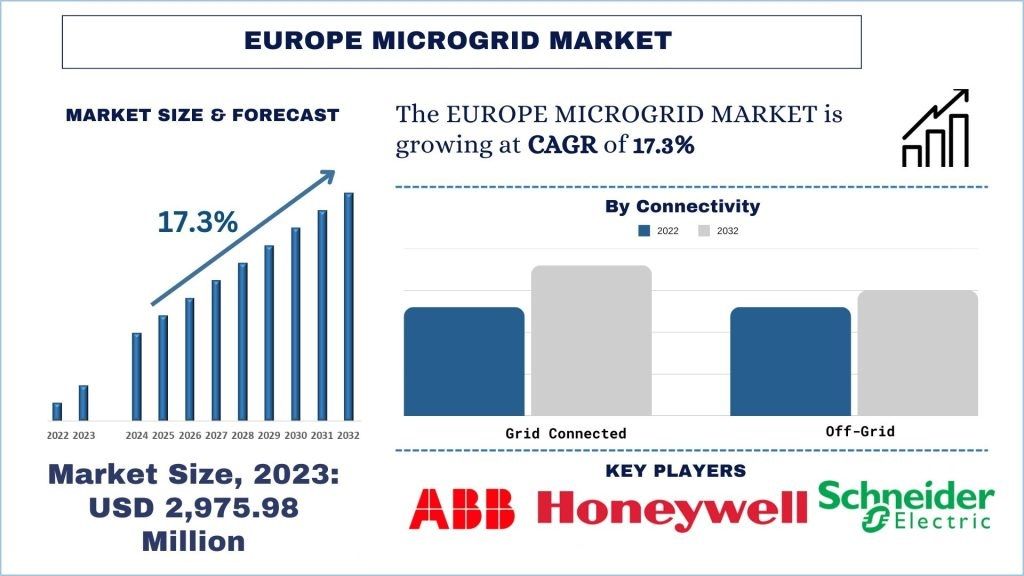
Wielkość i prognoza rynku mikrosieci w Europie
Wartość rynku mikrosieci w Europie oszacowano na 2 975,98 milionów USD i oczekuje się, że wzrośnie ona ze znaczącym CAGR na poziomie około 17,3% w okresie prognozy (2024-2032) ze względu na rosnące zapotrzebowanie na czystą energię w regionie oraz rosnące wsparcie rządowe dla wdrażania mikrosieci w celu zapewnienia energii na obszarach wiejskich.
Analiza rynku mikrosieci w Europie
Rynek mikrosieci w Europie odnotowuje znaczny postęp w okresie prognozy. Rosnąca konieczność modernizacji starzejącej się infrastruktury i wdrożenia energii elektrycznej poza siecią napędza popyt na instalację mikrosieci. Ponadto skupienie rządu na energii odnawialnej i rosnące zapotrzebowanie na elastyczność w mikrosieciach, które mogą być podłączone do różnych źródeł energii, takich jak energia słoneczna, gaz ziemny, hydroelektrownie itp., w celu wytwarzania energii elektrycznej w Europie, prowadzą do wdrażania mikrosieci. Co więcej, rządy w krajach takich jak Niemcy, Wielka Brytania i Francja inwestują w mikrosieci, aby zwiększyć udział energii odnawialnej w miksie wytwarzania energii i zmniejszyć emisję gazów cieplarnianych. Ponadto, szybkie przejście na pojazdy elektryczne w Europie zwiększyło liczbę stacji ładowania EV, z których wiele wykorzystuje mikrosieci. Oczekuje się, że trend ten będzie się utrzymywał, co dodatkowo obniży popyt na mikrosieci.Na przykład w 2023 r. brytyjska mennica uruchomiła nowe wielozasobowe centrum energetyczne mikrosieci. Mikrosieć wielotechnologiczna obejmuje energię słoneczną, wiatr, kogenerację i magazynowanie energii w bateriach o podwójnej chemii.Ponadto, szybkie przejście na pojazdy elektryczne w Europie zwiększyło liczbę stacji ładowania EV, z których wiele wykorzystuje mikrosieci. Oczekuje się, że trend ten będzie się utrzymywał, co dodatkowo obniży popyt na mikrosieci. Mikrosieci ułatwiają integrację technologii energii odnawialnej, takich jak energia słoneczna i wiatrowa, z miksem energetycznym. Jest to zgodne z zobowiązaniem Europy do redukcji emisji gazów cieplarnianych i przejścia na bardziej zrównoważony system energetyczny. Oczekuje się, że czynniki te, w połączeniu z trwającymi inwestycjami i inicjatywami rządowymi, będą nadal napędzać wzrost rynku mikrosieci w Europie.
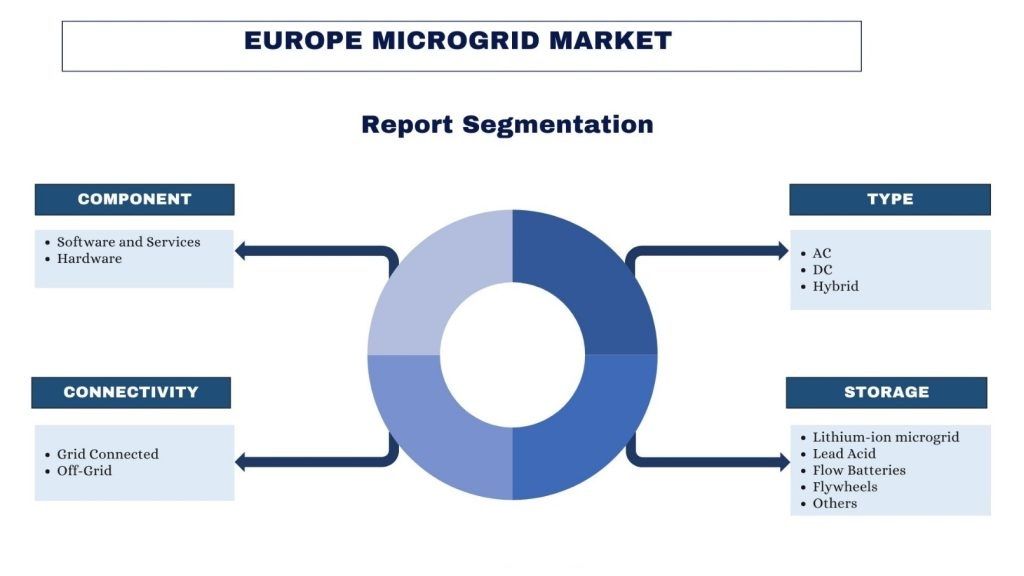
Trendy na rynku mikrosieci w Europie
Rosnące wsparcie rządu
Wybitnym trendem wsparcia rządowego dla mikrosieci w Europie, szczególnie po 2021 r., jest istotny rozwój mający na celu promowanie odpornych i zrównoważonych systemów energetycznych. Mikrosieci to zlokalizowane systemy energetyczne, które mogą działać niezależnie od głównej sieci, integrując różne rozproszone zasoby energii, takie jak odnawialne źródła energii, systemy magazynowania energii i sterowalne obciążenia. Oferują one zwiększoną niezawodność, odporność i potencjalne oszczędności kosztów poprzez zmniejszenie zależności od tradycyjnej scentralizowanej sieci. Wsparcie rządowe dla mikrosieci nabiera tempa w Europie, napędzane przez czynniki takie jak potrzeba niezawodnej i odpornej infrastruktury energetycznej, przejście na czystsze źródła energii oraz potencjalne korzyści ekonomiczne lokalnej produkcji energii.
- Pakiet Czysta Energia dla Europy 1: Przyjęty w 2019 r., pakiet ten pomaga w dekarbonizacji systemu energetycznego UE zgodnie z celami Europejskiego Zielonego Ładu. Pakiet obejmuje 8 nowych przepisów, w tym dyrektywę w sprawie charakterystyki energetycznej budynków i dyrektywę w sprawie energii odnawialnej. Każdy kraj UE jest zobowiązany do ustanowienia zintegrowanych 10-letnich krajowych planów w zakresie energii i klimatu (KPEiK) na lata 2021-30.
- Europejski Zielony Ład i Plan „Gotowi na 55”: Uruchomione odpowiednio w 2020 i 2021 r., inicjatywy te mają na celu ograniczenie emisji CO2 o 55 procent do 2030 r. (w stosunku do poziomów z 1990 r.) i osiągnięcie zerowej emisji netto do 2050 r.
- Plan REPowerEU: Zapowiedziany na początku 2022 r., plan ten wprowadził środki mające na celu szybkie zmniejszenie zależności od rosyjskich paliw kopalnych i przyspieszenie zielonej transformacji.
Europa zdominowała rynek mikrosieci w Europie
Wartość rynku mikrosieci w Europie w 2023 r. wyniosła 2 975,98 mln USD i oczekuje się, że osiągnie 11 722,83 mln USD przy CAGR na poziomie 17,3%. Rosnąca konieczność modernizacji starzejącej się infrastruktury i wdrażania energii elektrycznej poza siecią napędza popyt na instalację mikrosieci. Ponadto skupienie rządu na energii odnawialnej i rosnące zapotrzebowanie na elastyczność w mikrosieciach, które mogą być podłączone do różnych źródeł energii, takich jak energia słoneczna, gaz ziemny, hydroelektrownie itp., w celu wytwarzania energii elektrycznej w Europie, prowadzą do wdrażania mikrosieci. Co więcej, rządy w krajach takich jak Niemcy, Wielka Brytania, Francja i reszta Europy inwestują w mikrosieci, aby zwiększyć udział energii odnawialnej w miksie wytwarzania energii i zmniejszyć emisję gazów cieplarnianych. W rezultacie różne inicjatywy, takie jak plan REPowerEU, opierają się na pakiecie „Gotowi na 55” i mają na celu przyspieszenie wysiłków dekarbonizacyjnych poprzez efektywność energetyczną i działania na rzecz energii odnawialnej w celu wyeliminowania zależności od rosyjskich paliw kopalnych. Dlatego Komisja zaproponowała zwiększenie unijnego celu w zakresie energii odnawialnej do 2030 r. do 45%, co oznacza znaczne przyspieszenie wdrażania odnawialnych źródeł. Szacuje się, że w latach 2020–2030 udział energii wiatrowej i słonecznej w zainstalowanych zdolnościach produkcyjnych energii elektrycznej w UE wzrośnie z 33% do 67%.
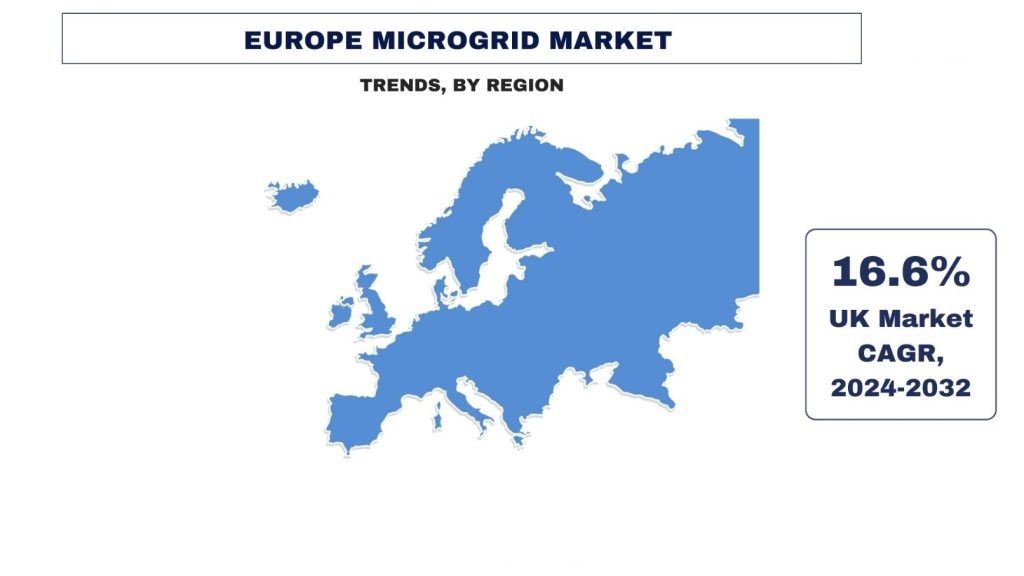
Przegląd branży mikrosieci w Europie
Rynek mikrosieci jest konkurencyjny, a także skoncentrowany, z obecnością bardzo niewielu europejskich i międzynarodowych graczy rynkowych. Kluczowi gracze przyjmują różne strategie wzrostu w celu zwiększenia swojej obecności na rynku, takie jak partnerstwa, umowy, współpraca, wprowadzanie nowych produktów, ekspansje geograficzne oraz fuzje i przejęcia. Niektórzy główni gracze działający na rynku to ABB, General Electric, Siemens AG, Eaton Corporation Inc., Schneider Electric SE, Honeywell International Inc., Caterpillar, Toshiba Corporation, Hitachi Energy Ltd i General Microgrids.
Zakres raportu z rynku mikrosieci w Europie
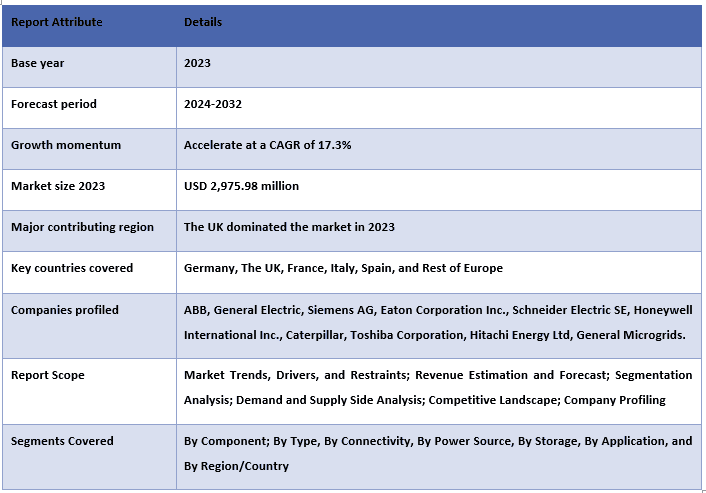
Powody, dla których warto kupić ten raport:
- Badanie obejmuje analizę wielkości i prognoz rynku, zatwierdzoną przez uwierzytelnionych kluczowych ekspertów branżowych.
- Raport krótko omawia ogólne wyniki branży w skrócie.
- Raport zawiera dogłębną analizę wybitnych podmiotów z branży, koncentrując się głównie na kluczowych finansach biznesowych, portfelach produktów, strategiach ekspansji i ostatnich osiągnięciach.
- Szczegółowe badanie czynników napędowych, ograniczeń, kluczowych trendów i możliwości występujących w branży.
- Badanie kompleksowo obejmuje rynek w różnych segmentach.
- Dogłębna analiza na poziomie regionalnym branży.
Opcje dostosowywania:
Rynek mikrosieci w Europie można dodatkowo dostosować do wymagań lub jakiegokolwiek innego segmentu rynku. Poza tym UMI rozumie, że możesz mieć własne potrzeby biznesowe; dlatego zachęcamy do kontaktu w celu uzyskania raportu, który w pełni odpowiada Twoim wymaganiom.
Spis treści
Metodologia badawcza dla analizy rynku mikrosieci w Europie (2024-2032)
Analiza historycznego rynku, oszacowanie obecnego rynku i prognozowanie przyszłego rynku rynku mikrosieci w Europie to trzy główne kroki podjęte w celu stworzenia i analizy wdrażania mikrosieci w głównych krajach. Przeprowadzono wyczerpujące badania wtórne w celu zebrania historycznych danych rynkowych i oszacowania obecnej wielkości rynku. Po drugie, wzięto pod uwagę liczne ustalenia i założenia w celu walidacji tych spostrzeżeń. Ponadto przeprowadzono wyczerpujące wywiady pierwotne z ekspertami branżowymi w całym łańcuchu wartości rynku mikrosieci w Europie. Po założeniu i walidacji danych rynkowych za pomocą wywiadów pierwotnych, zastosowaliśmy podejście odgórne/oddolne do prognozowania pełnej wielkości rynku. Następnie zastosowano metody podziału rynku i triangulacji danych w celu oszacowania i analizy wielkości rynku segmentów i podsegmentów branży. Szczegółowa metodologia wyjaśniona poniżej:
Analiza historycznej wielkości rynku
Krok 1: Dogłębne badanie źródeł wtórnych:
Przeprowadzono szczegółowe badanie wtórne w celu uzyskania historycznej wielkości rynku rynku mikrosieci poprzez wewnętrzne źródła firmy, takie jakraporty roczne i sprawozdania finansowe, prezentacje wyników, komunikaty prasowe itp. oraz źródła zewnętrzne, w tym czasopisma, wiadomości i artykuły, publikacje rządowe, publikacje konkurencji, raporty sektorowe, bazy danych stron trzecich i inne wiarygodne publikacje.
Krok 2: Segmentacja rynku:
Po uzyskaniu historycznej wielkości rynku rynku mikrosieci, przeprowadziliśmy szczegółową analizę wtórną w celu zebrania historycznych informacji rynkowych i udziału dla różnych segmentów i podsegmentów dla głównych regionów. Raport obejmuje główne segmenty: komponenty, łączność, typ, źródło zasilania, magazynowanie i zastosowanie. Przeprowadzono dalsze analizy na poziomie krajowym w celu oceny ogólnego wdrażania modeli testowych w danym regionie.
Krok 3: Analiza czynnikowa:
Po uzyskaniu historycznej wielkości rynku różnych segmentów i podsegmentów, przeprowadziliśmy szczegółowąanalizę czynnikowąw celu oszacowania obecnej wielkości rynku rynku mikrosieci. Ponadto przeprowadziliśmy analizę czynnikową z wykorzystaniem zmiennych zależnych i niezależnych, takich jak komponent, łączność, typ, źródło zasilania, magazynowanie i zastosowanie rynku mikrosieci. Przeprowadzono dokładne badanie scenariuszy popytu i podaży, biorąc pod uwagę najważniejsze partnerstwa, fuzje i przejęcia, ekspansję biznesu oraz wprowadzenia produktów na rynku mikrosieci.
Szacunkowa wielkość i prognoza obecnego rynku
Bieżące szacowanie wielkości rynku:W oparciu o praktyczne wnioski z powyższych 3 kroków, określono obecną wielkość rynku, kluczowych graczy na europejskim rynku mikrosieci oraz udziały rynkowe segmentów. Wszystkie wymagane podziały udziałów procentowych i podziały rynku zostały określone przy użyciu powyższego podejścia wtórnego i zweryfikowane poprzez wywiady pierwotne.
Szacowanie i prognozowanie:Do oszacowania i prognozowania rynku przypisano wagi różnym czynnikom, w tym czynnikom napędzającym i trendom, ograniczeniom i możliwościom dostępnym dla interesariuszy. Po przeanalizowaniu tych czynników zastosowano odpowiednie techniki prognozowania, tj. podejście odgórne/oddolne, aby uzyskać prognozę rynku na rok 2032 dla różnych segmentów i podsegmentów na głównych rynkach Europy. Metodologia badawcza przyjęta do oszacowania wielkości rynku obejmuje:
- Wielkość rynku branży pod względem przychodów (USD) oraz wskaźnik adopcji rynku mikrosieci na głównych rynkach krajowych
- Wszystkie udziały procentowe, podziały i podziały segmentów i podsegmentów rynku
- Kluczowi gracze na europejskim rynku mikrosieci pod względem oferowanych produktów. Ponadto strategie wzrostu przyjęte przez tych graczy, aby konkurować na szybko rozwijającym się rynku.
Walidacja wielkości i udziału w rynku
Badania pierwotne:Przeprowadzono dogłębne wywiady z kluczowymi liderami opinii (KOL), w tym z kierownictwem wyższego szczebla (CXO/Wiceprezesi, Szefowie Sprzedaży, Szefowie Marketingu, Szefowie Operacji, Szefowie Regionalni, Szefowie Krajowi itp.) w głównych regionach. Wyniki badań pierwotnych zostały następnie podsumowane i przeprowadzono analizę statystyczną w celu udowodnienia postawionej hipotezy. Dane wejściowe z badań pierwotnych zostały skonsolidowane z wynikami wtórnymi, przekształcając w ten sposób informacje w praktyczne wnioski.
Podział uczestników badań pierwotnych w różnych regionach
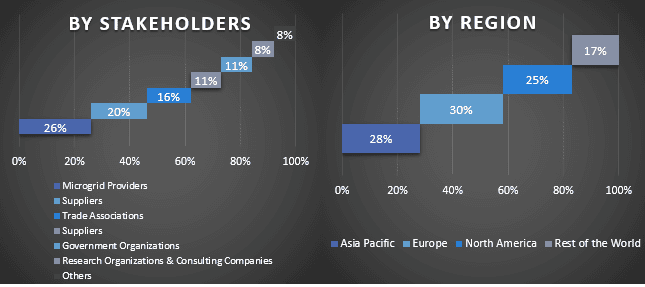
Inżynieria rynku
Triangulacja danych została wykorzystana do zakończenia ogólnego oszacowania rynku i uzyskania precyzyjnych liczb statystycznych dla każdego segmentu i podsegmentu europejskiego rynku mikrosieci. Dane zostały podzielone na kilka segmentów i podsegmentów po przestudiowaniu różnych parametrów i trendów w obszarach komponentów, łączności, typu, źródła zasilania, magazynowania i zastosowania na europejskim rynku mikrosieci.
Główny cel badania europejskiego rynku mikrosieci
Bieżące i przyszłe trendy rynkowe na europejskim rynku mikrosieci zostały wskazane w badaniu. Inwestorzy mogą uzyskać strategiczne spostrzeżenia, aby oprzeć swoje decyzje inwestycyjne na analizie jakościowej i ilościowej przeprowadzonej w badaniu. Bieżące i przyszłe trendy rynkowe zdeterminowały ogólną atrakcyjność rynku na poziomie regionalnym, zapewniając platformę dla uczestnika przemysłowego, aby wykorzystać niewykorzystany rynek i skorzystać z przewagi pierwszego gracza. Inne cele ilościowe badań obejmują:
- Analizę bieżącej i prognozowanej wielkości rynku mikrosieci pod względem wartości (USD) oraz bieżącej i prognozowanej wielkości rynku różnych segmentów i podsegmentów.
- Segmenty badania obejmują komponenty, łączność, typ, źródło zasilania, magazynowanie i zastosowanie.
- Zdefiniowanie i analiza ram regulacyjnych dla mikrosieci
- Analiza łańcucha wartości z obecnością różnych pośredników, wraz z analizą zachowań klientów i konkurentów w branży.
- Analiza bieżącej i prognozowanej wielkości rynku mikrosieci dla głównego regionu.
- Główne kraje i regiony objęte badaniem to Niemcy, Wielka Brytania, Francja, Włochy, Hiszpania i reszta Europy.
- Profile firm na rynku mikrosieci oraz strategie wzrostu przyjęte przez graczy rynkowych w celu utrzymania się na szybko rozwijającym się rynku.
- Dogłębna analiza regionalna branży
Najczęściej zadawane pytania FAQ
P1: Jaki jest obecny rozmiar rynku mikrosieci w Europie i potencjał wzrostu?
Pytanie 2: Jakie czynniki napędzają wzrost rynku mikrosieci?
P3: Który segment ma największy udział w rynku mikrosieci według typu?
P4: Jakie są wschodzące technologie i trendy na rynku mikrosieci?
P5: Który kraj zdominuje rynek mikrosieci?
Powiązane Raporty
Klienci, którzy kupili ten przedmiot, kupili również










